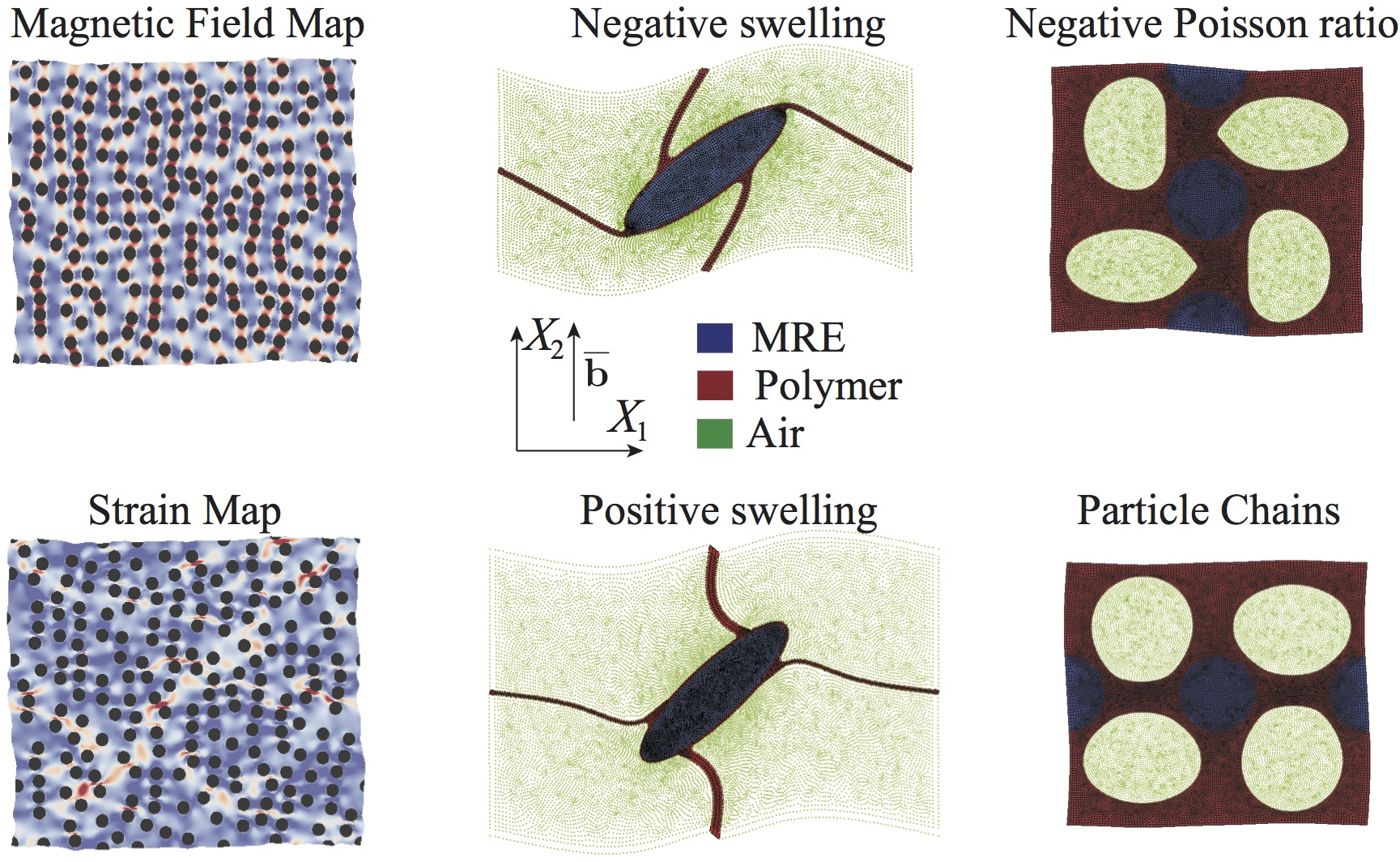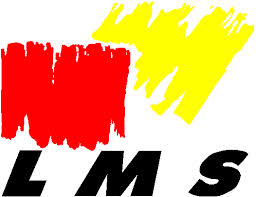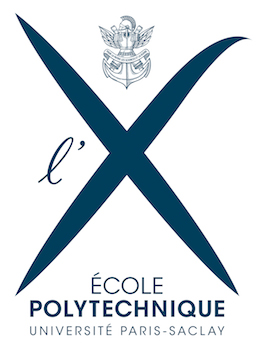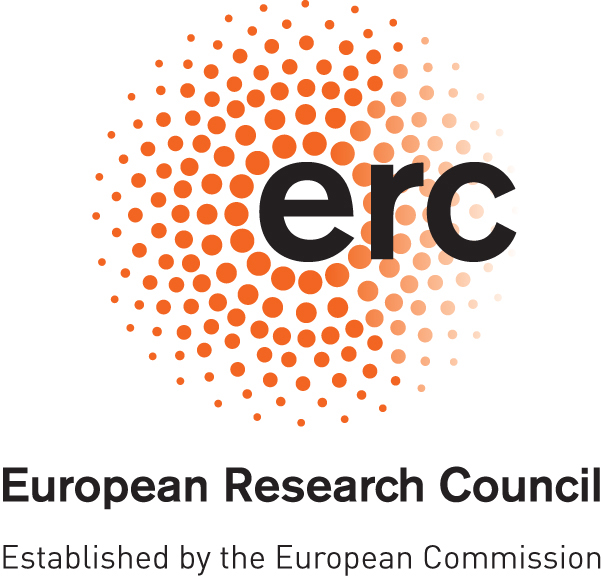MRE Film/Substrate Instabilities
From an unconventional point of view, a remarkable property of
magnetorheological elastomers (MREs) is that while they can become
unstable by combined magneto-mechanical loading, their response is
well controlled in the post-instability regime. This, in turn,
allows us to try to operate these materials in this critically
stable region. These instabilities can lead to extreme responses
such as wrinkles (for haptic applications), actively controlled
stiffness (for cell-growth) and acoustic properties with only
marginal changes in the externally applied magnetic fields. Unlike
the current modeling of hierarchical composites, MREs require the
development of advanced coupled nonlinear magneto-mechanical models
in order to tailor the desired macroscopic instability response at
finite strains. Due to their coupled magnetoelastic response, MREs
are finding an increasing number of engineering applications. One
such application is in haptics, where the goal is to actively
control surface roughness and curvature. One way to achieve this is
by exploiting the unstable regime of MRE substrate/layer assemblies
subjected to transverse magnetic fields.
Hierarchical Instabilities

Man-made meta- materials and structures have received much attention
over the past decades thanks to their aptitude for tailoring
selected properties. Superior acoustic, photonic and
mechanical properties can be deliberately achieved at the
macroscale by ratioaally designing the structure’s unit-cell
geometry and level of hierarchy. Hierarchical nanocomposites
mimicking biological materials such as nacre, teeth and bone as well
as cellular materials with periodic architecture are both examples
of metamaterial systems. In this subject, we combine numerical
simulations with compressive testing of 3D printed polymer structures to investigate the buckling
response of a slender column, whose architecture employs unit-cell
lattices which in turn consist of a sequence of columns uniformly
spaced. This way we create a hierarchical structure that can
contrallbly become unstable at different scales. The lower-scale
columns are both of comparable size with the macro-geometry and a
priori susceptible to buckling. Within the accuracy of data, the
experimental trends are consistent with the numerical simulations
and show that both the buckling and the post-buckling response at
the macroscopic (i.e. continuum) level are dependent on the lower-scale
microstructure.
3D Printed Materials

The proposed subject aims at developing a dialogue between a real
microscopic image of a composite material (such as an MRE) obtained by
optical and electron microscopy as well as 3D tomographic techniques
and mathematically constructed virtual microstructures. These
virtual microstructures can be analyzed via numerical tools such as
finite elements and/or fast-Fourrier Transforms (FFT) methods at
different scales. Subsequently these virtual microstructures can be
directly printed in a 3D printer. The printed
material can then be tested experimentally in order to probe the
response of the original material and validate the several methods
used to reach this point.
Microstructured MREs

This subject provides a rigorous analysis of the effective response,
i.e., average magnetization and magnetostriction, of magnetoelastic
composites that are subjected to overall magnetic and mechanical
loads. It attempts to clarify the differences between a coupled
magnetomechanical analysis in which one applies a Eulerian (current)
magnetic field and an electroactive one where the Lagrangian
(reference) electric field is usually applied. For this,
an augmented vector potential variational formulation is developed to carry out
numerical periodic homogenization studies of magnetoelastic solids
at finite strains and magnetic fields. We show that the developed
variational principle can be used for bottom-up design of
microstructures with desired magnetomechanical coupling by properly
cancelling out the macro-geometry and specimen shape effects.
As an example, we show above random isotropic microstructures
based on random adsorption algorithms as well as novel
three-phase auxetic microstructures. The first takes advantage of
particle shape and geometrical chirality to produce
negative and positive swelling, while the second uses a periodic
distribution of voids and particle chains in a polymer matrix.
Liquid Crystals

Of interest here is the fully three-dimensional analysis of the
Freedericksz transition for the twisted nematic device (TND), which is
widely used in liquid-crystal display monitors. Using a coupled
electromechanical variational formulation, the problem is treated as a
bifurcation instability triggered by an externally applied electric
field. More specifically, we study a finite thickness liquid-crystal
layer, anchored between two infinite parallel plates relatively
rotated with respect to each other by a given twist angle and
subjected to a uniform electric field perpendicular to these bounding
plates. The novelty of the proposed analysis lies in the fully
three-dimensional formulation of the TND problem that considers all
possible bounded perturbations about the principal solution. By
scanning a wide range of the liquid crystal’s material parameter
space, we establish whether the Freedericksz transition is global,
i.e., has an eigenmode depending solely on the layer thickness
coordinate, or local (also termed the periodic Freedericksz
transition), i.e., has an eigenmode with finite wavelengths in one or
both directions parallel to the plate. It is found that global modes
are typical for low values, while local modes appear at large values
of the twist angle. Moreover, for certain TND’s, the increase in twist
angle can lower the critical electric field, findings that could be
useful in guiding liquid-crystal selection for applications.



